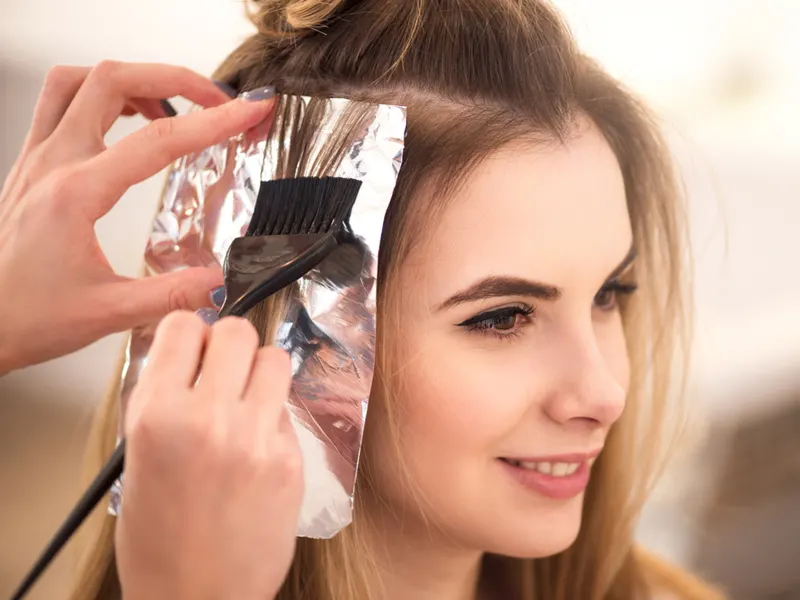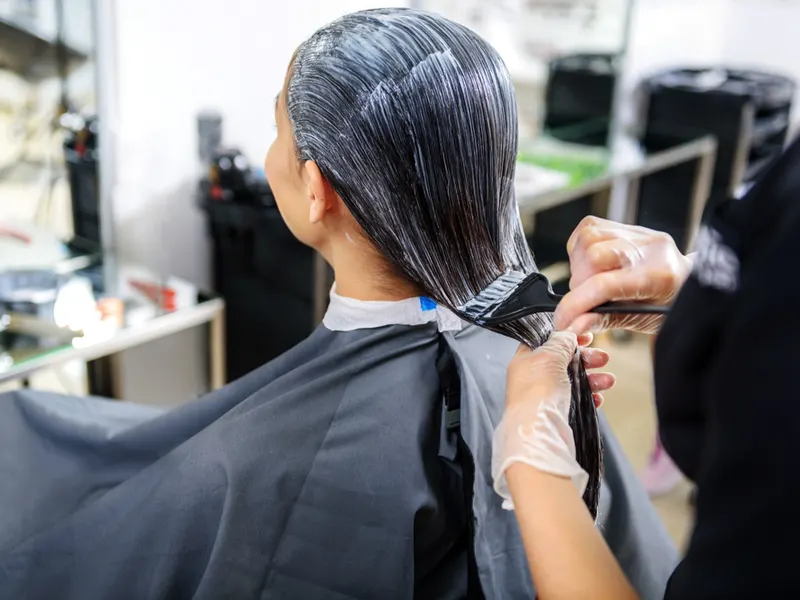Jump to:
Are you wondering how to color your high porosity hair correctly? Then you’ve come to the right place. We’ve created a comprehensive guide on how to color your stubborn porous hair properly.
What Is Hair Porosity?
Porous hair is something you naturally either have or don’t have. Porosity pretty much refers to how absorbent your hair is. If you’re not familiar with the term “porous hair,” stop here to learn about the differences in hair porosity.
Hair can range between high and low porosity. This ability to absorb and retain moisture also affects how well your hair will absorb chemicals like hair dye. So, you should understand your hair’s porosity before coloring your hair. Porosity, like hair type, can be genetic.
Even if you’ve never processed your hair, you could have highly porous hair. Coarser, thicker hair tends to be high porosity, but that’s not always true. Sometimes it’s extremely low porosity.
However, your hair type isn’t the only thing that decides your porosity. Texture, color, and past chemical treatments can affect your hair’s current porosity. It can change as your hair goes through wear and tear and gets damaged from over-processing.
How Hair Porosity Affects Coloring

Yakobchuk Viacheslav/Shutterstock
As we mentioned, your hair’s porosity could mess up your dye job. That’s because the ability to absorb and retain hair color is dependent on your hair/curl type. High and low porosity hair each come with their own coloring challenges.
High porosity hair should easily absorb hair color. However, it can absorb color too fast if it’s exceptionally porous. Some sections of hair will absorb more color than others, and you’ll get an uneven dye job.
Highly porous hair may also have trouble holding the color. It’ll run right through the strand and onto your scalp. Usually, leaving the color in for less than the suggested time can help. Low porosity hair has the opposite problem.
It can be difficult for the color to penetrate the shaft. That means that hair dye may create little or no change in your hair, but this can usually be solved by leaving the color in longer than the suggested time.
Of course, leaving chemicals in your hair for a long time puts you at risk for hair damage. You’ll need to change your coloring tactics based on your hair type to achieve the best possible color results.
Not sure about your hair type? Take our super simple hair type quiz now! It’s only 5 short questions and will tell you what products to use, which ones to avoid, and a few other helpful tips for caring for your hair.
Should You Dye Highly Porous Hair?
Extremely high-porosity hair could be natural, but most often it’s caused by damage. Ideally, you should hold off on coloring damaged hair or exposing it to any amount of processing so you can have a chance to repair it.
There are some easy steps to take if you want to try to repair your high-porosity hair. That will increase its health, reduce breakage, frizz, and make it easier to color in the future, assuming you can get it to medium porosity.
How to Repair High Porosity Hair
Follow these tips if you know your hair is already damaged and want to revitalize it without paying for expensive salon treatments:
- Use low or no heat. If your hair is very damaged, skip any heat that you can. Try to air-dry your hair as often as possible. If you must use a dryer, use it on low or even cool.
- Deep condition it. Try some deep conditioning treatments to help protect the hair.
- Try out different, low-effort hairstyles. That means keeping to your natural hair for as long as possible. Most damage is caused by over-processing. The new growth should be healthy since it’s untouched if you use minimal (ideally zero) products in your hair for a while.
- Try a hair mask. Highly porous hair is very absorbent. If you use conditioning and protein treatments (like a hair mask), it should absorb those things easily too. You can have healthier hair again quickly if you keep up with treatments.
Causes of High Porosity Hair
To keep your repairs from being undone, you should be aware of the ways you can damage your hair. Remember, high porosity hair means damaged cuticles. Here’s what can do that:
- Over-bleaching
- Over-processing: any excessive or regular hair treatments (like regular dye jobs) that use chemicals can damage the cuticle
- Frequent heat treatments
- Saltwater
- UV damage
- Regular relaxers or permanent straightening treatments
Read Next: Common Signs of Hair Damage
Determining Your Hair’s Porosity

art4stock/Shutterstock
Now that you know you’ll have to adjust your dye time based on your hair’s porosity, you should probably know how porous your hair is. Figuring out your hair type is easy. There are a couple of simple porosity tests you can perform yourself. Neither should take you more than a minute to do.
The Touch Test
One way to quickly gauge porosity is to take a strand of your hair between your fingers and run them up the length of the strand, starting from the ends, towards your scalp. Your hair is porous if it feels bumpy instead of smooth.
You probably also have frizz or split ends. The cuticles in porous hair are lifted or raised. Even if you can’t see that it’s lifted, you’ll feel that your hair isn’t smooth.
The Water Test
You can also try the water test if you aren’t sure just from feeling up your hair. The water test is also easy to do. You’re just going to watch your hair sink or float. Grab a clear cup and fill it with water. Take out a strand of your hair, and place it in the water.
If your hair immediately sinks to the bottom, it’s highly porous because it immediately took on water. It’s medium porosity if it sinks slowly down and probably doesn’t even reach the bottom. It’s low porosity if it stays floating at the top.
The Easiest Option: Take Our Quiz
If the above steps sound like too much work, you should know that they are. We build a free and short hair porosity quiz to help you easily determine your hair’s porosity by answering three simple questions.
Read Next: What Is My Hair Porosity? Quiz
What Happens When You Dye Porous Hair?
So, you should now be sure that you do indeed have porous hair. You’re going to face some specific dye challenges if this is the case. You shouldn’t have too much trouble applying the hair dye.
The color should absorb quickly and easily, so the only problem will be too much absorption. The color will be much richer and darker than what you thought you would get if you leave it on for too long.
You should probably leave the color in for a few minutes less than the suggested time. You can always add more if needed. For some hair types, you might have the opposite problem.
The color will seem normal but wash out too easily since your hair has trouble retaining the chemicals. To get the best dye results for porous hair, there is some preparatory work that you can do.
How to Prep Porous Hair for Coloring
There are a few things you could try to do before coloring your high porosity hair. These will help strengthen your hair and tighten the cuticle so the color will be more even.
Trim Your Hair
The ends of your hair tend to take the most damage. Getting a trim will get rid of the highest-porosity parts of your hair.
You can easily trim hair yourself. But, if you’re concerned about coloring porous hair, you can use this step to go to a stylist and have them suggest the best pre-coloring steps for your specific hair type.
Moisturize Your Hair
High porosity hair tends to be brittle, prone to breakage, and dry. In the weeks leading up to your hair appointment, you can try a couple of deep-conditioning sessions. That will help to repair the brittle strands.
This option isn’t ideal if you’re in a hurry to cover up a previous coloring job, grey strands, or you don’t want to wait. Long-term moisturizing regimens can take weeks to show results. If you have the time, it’s worth it for hair health.
Use Protein Fillers
Or consult a hairstylist before you do. They may recommend protein fillers to help repair the cuticle before coloring if your hair is very damaged or extremely porous for any reason.
Protein fillers contain hydrolyzed proteins that can help fill out the hair cuticle. Using a protein filler will give your hair thicker and smoother strands overall. A protein filler can prevent uneven color results and protect against chemical damage.
Use a Clarifying Shampoo
This should be done the day before your coloring appointment or at-home attempt. Clarifying shampoo can actually damage hair. So only do it once to remove any product or oil buildup.
This way, you have a clean head, and you won’t risk applying dye on top of previous products or even natural oil, which can keep the dye from settling correctly.
Frequently Asked Questions

Olena Yakobchuk/Shutterstock
Here are the most frequently asked questions for dyeing and maintaining color in your porous hair.
How do you get hair dye to stay in porous hair?
You should follow the steps you would usually take to maintain the color of your porous hair. Wash your hair less often and use a color-protecting sulfate-free shampoo and conditioner when you do.
Also choose the correct toning shampoo for your color. For example, you can use purple shampoo for blonde or silver dyes and blue for brunette tones.
How do you fix porous bleached hair?
Rehydrating bleached hair will take time, but it’s not difficult. Skip excessive heat, use a hydrating hair mask, and wash your hair less often but use more conditioner when you do.
Why is my hair not holding color?
Medium-to-high porosity hair will have trouble holding moisture as well as dyes. This means your color will fade faster as it leaches out of your hair. The rehydration and repair treatments for damaged hair we’ve discussed here should help your hair hold onto color for longer.
How long should you leave hair dye on porous hair?
High porosity hair will over-absorb color, leading to undesirable darker, duller results. If the suggested dye time for your color is around 30 minutes, you should probably only leave it in for 10-15 minutes to avoid oversaturation.
Also, high porosity hair is weak so you don’t want to leave any chemical treatment in for too long as it will lead to even further damage.
Why does my hair color wash out so fast?
High porosity hair could be the cause of quick-fading hair color, and low-porosity hair often needs increased saturation time. Specific hair colors and types require more leave-in time than others. Gray hair, for instance, is often low porosity.
So, How Does Coloring Porous Hair Work?
Coloring porous hair isn’t too difficult if you consult a stylist and take steps to strengthen your hair. Make sure you leave color in for a short amount of time to avoid over-saturation and an uneven coloring outcome if you don’t want to wait to decrease damage.
Afterward, take the proper hair care steps for dyed hair. Use shampoos and conditioners that protect colored hair, and make sure not to over-wash.
